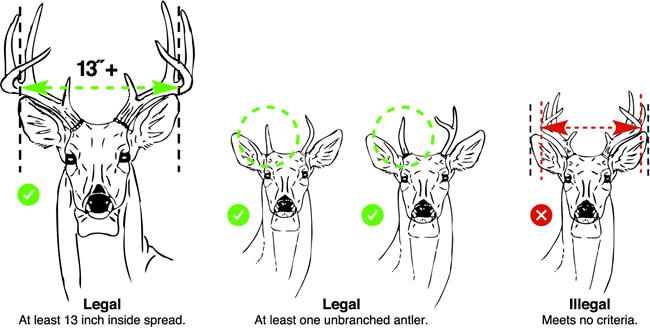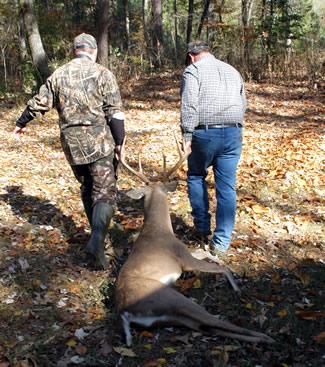
November 10, 2017 - There was a time in East Texas deer hunting when just about any deer was acceptable on the camp meat pole so long as it had antlers. But that's hardly the case anymore.
As more and more deer hunters become interested in managing deer herds in a quest for quality instead of just plain ol' deer, many clubs had much rather see somebody show up at the camp house with a plump doe or nothing at all as opposed to a promising young buck that falls short of qualifications established by club bylaws.
 Some hunting clubs take their buck harvest rules so seriously that members can face some serious repercussions if they break them. I've heard of some slapping members with fines upwards of $500 for killing a buck that doesn't meet the minimum harvest criteria, which is often gauged the number of points on the rack, the inside spread or a combination of the two.
Some hunting clubs take their buck harvest rules so seriously that members can face some serious repercussions if they break them. I've heard of some slapping members with fines upwards of $500 for killing a buck that doesn't meet the minimum harvest criteria, which is often gauged the number of points on the rack, the inside spread or a combination of the two.
Do it more than once and you could find yourself looking for a new lease to hang your climber. You could even find yourself in hot water with the law if you are hunting in a county with antler restrictions and make the mistake of pulling the trigger on a buck that doesn't make the grade.
If you deer hunt in East Texas, the antler restriction regulation is definitely something you should be aware of. Antler restrictions were first implemented as a experiment in the early 2000s in six southeast Texas counties. Since that time the regulation is been expanded to more than 100 East Texas counties.
The current regulation limits hunters to two bucks per season. One of the bucks must have an inside spread 13 inches or more, while the second must be a spike or have at least one unbranched antler.
The regulation is centered largely around antler dimensions and is aimed at improving the age structure of a deer herd with a deep history of mauled at a very young age. Historically, 1 1/2 and 2 1/2 year old bucks have comprised as much as 70 percent of the annual buck harvest East Texas.
One of TPWD's main objectives for implementing the antler restriction was to reduce the harvest pressure on young bucks and to improve the overall age structure of the buck herd by allowing more deer to reach at least 3 1/2 years of age before they become legal to shoot. The antler reg is essentially built-in management, because it more or less forces hunters to lay off of young bucks.
Biologists also believed an older age structure among the buck herd would lead to some positive biological implications including a more defined rut and a shorter breeding season that would ultimately put more fawns on the ground at close to the same time, promote better fawn survival and lead to a healthier deer herd overall.
There is plenty of evidence to support the theory that antler restrictions have helped improved the age structure of the region's buck herd. Deer hunters are killing more bucks age 3 1/2 and older around here than ever before.
Regardless, mistakes are still going to happen out there. And misjudging the rack on a whitetail buck can be a deer hunter's worst nightmare, similar to the one experienced by a tournament angler who shows up at weigh in with a fish that falls short of minimum length limit.
Anyone who has pulled the trigger on a buck that turns out to be smaller than originally thought knows the empty feeling that comes when the "ground shrinkage" curse comes calling. It can happen to anybody, no matter how many years of hunting experience a hunter has under the belt.
As interest in quality deer management continues to gain popularity, more and more hunters are learning to better evaluate deer before the decision is made to click the safety to the off position.
Learning to tell the difference between a young buck and mature one isn't rocket science. It is more about learning to recognize some of the physical characteristics that separate the two.
Well-known wildlife biologist Al Brothers and wildlife photographer Dave Richards co-authored a book on the subject titled "Observing and Evaluation Whitetails. They also prepared a condensed field guide on the topic.
If you're looking for some educational reading material to take to the stand this season you might want to check it out. The 22-page water resistant field guide sells for $4.99 on the Quality Deer Management Association website, qdma.com.
I reviewed the book a few years back. It's bristling with good information and high quality photographs to compare bucks and the different physical features that be relied on to help distinguish between adolescence and maturity.
It's interesting stuff, yet it doesn't change the fact that the size of the crown a buck wears on its head is what catches the eye of most deer hunters.
When a true whopper walks out, many hunters with a good eye won't take the time to look for a sway in the back, sag in the belly, grey around the eyes and other physical traits that can help distinguish an old man and a young one.
They are more interested in points, mass, symmetry, beam length, tine length and inside spread. Those are the factors that determine the difference between a good buck and a great one for most deer hunters. Here is an explanation of each:.
- Points: Points are determined by counting the number of tines or points on the rack. The Boone and Crockett Club, the official record keeper for North American big game animals, requires that a point be at least one inch in length before it can be calculated into the official score of the rack.
- Mass - Mass is determined by calculating the thickness or circumference of the antler from the base to the outer reaches of the main beam. B&C scorers take into account several mass measurements when evaluating a rack.
- Tine Length - This is the length of the individual points. The longer the points, the more impressive the rack.
- Symmetry: This refers to how similar the rack is from side to side. A near perfect typical rack will have the same number of points with nearly identical tine lengths on both antlers.
- Beam Length: This is the measurement from the base of the antler to the tip of the antler.
- Inside Spread: This is the measurement between the widest point of the main beams. Many hunters place a lot of emphasis on the inside spread of a rack, even though it accounts for a very small percentage of a B&C score.
As earlier mentioned inside spread weighs heavy in harvest regulations in eastern Texas. How do you tell the difference between a legal buck and one that is not? The best advice is to look it over closely.
Spikes are fairly easy to pick out. However, determining the difference between a buck with a 12-inch or 13-inch spread can be difficult, especially at long distances.
High quality binoculars can help. Compare the antlers to the ears when in the alert position. If the distance between the antlers is equal to the distance between the ears the buck is probably a legal shooter.
If you are unsure, be smart and pass on the shot. Another year will make a noticeable difference.
Matt Williams is a freelance writer based in Nacogdoches. He can be reached by e-mail, mattwillwrite4u@yahoo.com.









